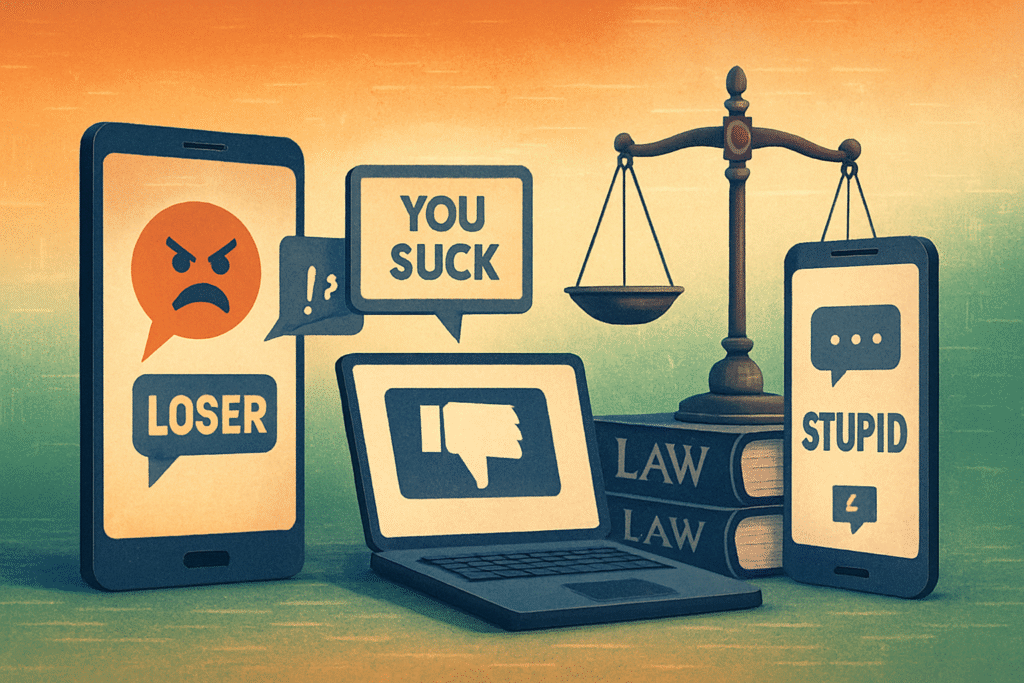Published On: 22nd August, 2024
Case title and citation:
Case Name: Shreya Singhal Vs. Union Of India
Court: Supreme Court Of India
Date: 24th of March 2015
Citation: AIR 2015 SC1523
Judges: The Supreme Court division bench comprising Justices J Chelameswar and Rohinton Fali Nariman.
Facts of the Case:
The Case began with a PIL filed by the petitioner, Shreya Singhal, challenging the Constitutionality of Section 66A of the Information Technology Act 2000. The Attorney General, representing the Union Of India, was the defendant tasked with defending the constitutionality of the statute.
The Nature of the case is Constitutional Law, with the petitioner arguing that the concerned provision of the IT Act violated the Fundamental Right of Freedom of Speech guaranteed under Article 19 of the Constitution of India.
Shreya Singhal filed the PIL in the Hon’ble Supreme Court. Following the said PIL, many petitions were filed challenging the provisions of the IT Act 2000.
In 2012, the Mumbai police arrested Shaheen Dhada and Rinu Srinivasan for expressing their dismay on Facebook over a bandh called in response to the death of Shiv Sena leader Bal Thackeray. Their arrest under Section 66A of the IT Act 2000 led to widespread outrage and highlighted the arbitrary application of the law.
The arrests triggered nationwide protests against the misuse of Section 66A, revealing that law enforcement agencies were overstepping their authority by criminalizing legitimate expressions of opinion. Consequently, in January 2013, the central government issued an advisory requiring senior police officials’ approval before making arrests under Section 66A.
Amid the controversy, Shreya Singhal, a law student, filed a writ petition under Article 32 of the Constitution, challenging the constitutional validity of Section 66A. Her petition argued that the section violated the fundamental right to freedom of speech and expression guaranteed under Article 19(1)(a) of the Constitution.
Legal Issues:
- Whether Section 66A of the Information Technology Act, 2000, is constitutionally valid under Article 19(1)(a) of the Indian Constitution, which guarantees the right to freedom of speech and expression.
- Whether the restrictions imposed by Section 66A are reasonable under Article 19(2) of the Constitution.
- Whether Section 66A is vague and overbroad, leading to arbitrary enforcement.
Arguments:
Petitioner’s Argument:
Violation of Freedom of Speech: Section 66A unduly restricts the freedom of speech and expression guaranteed under Article 19(1)(a) and is not justified by the reasonable restrictions under Article 19(2).
The petitioners argued that Section 66A’s purpose—to address new types of crimes—is flawed. They assert that Sections 66B to 67C of the Information Technology Act, along with various provisions of the Indian Penal Code, are adequate for dealing with these crimes.
The petitioners’ counsel presented numerous arguments challenging the constitutionality of Section 66A. Primarily, they claim that Section 66A violates the fundamental right to free speech and expression and does not fall under any of the eight exceptions in Article 19(2). They argue that actions like causing annoyance, inconvenience, danger, obstruction, insult, injury, criminal intimidation, enmity, hatred, or ill-will are not covered by Article 19(2). Moreover, the creation of an offense under Section 66A is problematic due to its vagueness. Unlike the clearly defined offense in Section 66 of the same Act, the terms used in Section 66A are not defined and likely cannot be defined. This lack of clarity means that both innocent and guilty individuals could be prosecuted, leaving people uncertain about whether their actions are lawful or not. This gives authorities excessive discretion, potentially leading to arbitrary enforcement. In practice, many innocent individuals have been unjustly prosecuted under this section, with numerous examples documented in a note to the Court. The enforcement of Section 66A effectively acts as a form of censorship, undermining the fundamental value of freedom of speech and expression protected by Article 19(1)(a). Additionally, this section has a chilling effect on free speech, deterring people from expressing diverse viewpoints, thereby infringing the rights of viewers who are deprived of a wide range of perspectives available on the internet.
The petitioners further contend that Section 66A violates their rights under Articles 14 and 21. They argue that there is no rational distinction between those who use the Internet and those who communicate through other spoken or written mediums. Penalizing someone based on their use of a specific communication medium is inherently discriminatory and violates Article 14.[1]
Discriminatory Application: The section discriminates against electronic communication, targeting a specific means of expression without any intelligible differentia, violating Article 14.
Defendant’s Argument:
Functional Interpretation: Courts should interpret laws to make them functional and may read down provisions to align with constitutional principles.
Prevention of Abuse: The mere potential for abuse does not justify declaring a law unconstitutional. Vague language serves to protect against various forms of misuse.
Necessity for Protection: The loose language safeguards the public from harmful content disseminated via electronic communication.
The Defendant argued that the Legislature is in the best position to understand and appreciate the people’s needs and that the court shall interfere only when the statute clearly violates the Rights conferred to the citizens by the Constitution of India.
Court’s Analysis:
The Supreme Court examined the provision in light of the fundamental right to freedom of speech and expression and the permissible restrictions under Article 19(2).
– Article 19(1)(a) of the Indian Constitution guarantees the right to freedom of speech and expression.
– Article 19(2) allows reasonable restrictions on this right in the interests of the sovereignty and integrity of India, security of the state, friendly relations with foreign states, public order, decency or morality, or in relation to contempt of court, defamation, or incitement to an offense.
The court found that Section 66A used vague terms that were open to subjective interpretation, leading to arbitrary and disproportionate enforcement. It held that the terms “offensive,” “annoying,” and “inconvenient” were not sufficiently clear to enable individuals to understand what conduct was prohibited.
Judgment:
The Supreme Court, after considering the arguments from both sides, delivered a unanimous judgment declaring Section 66A of the I.T. Act, 2000, unconstitutional. Key points from the judgment include:
Section 66A Struck Down: The Court held that Section 66A is unconstitutional as it violates Article 19(1)(a) and is not saved by the reasonable restrictions under Article 19(2).
Sections 69A and 79: While Section 69A (relating to the blocking of online content) and the rules for its application were upheld, Section 79 was deemed valid only with specific limitations on intermediaries’ liability.
Section 118(d) of Kerala Police Act: This provision, similar to Section 66A, was also struck down for being violative of freedom of speech.
Significance:
The case reinforced the importance of clarity and precision in drafting laws that restrict fundamental rights. It underscored the judiciary’s role in safeguarding constitutional freedoms against legislative overreach.
This case set a precedent that vague and overbroad laws that impinge on fundamental rights are subject to strict scrutiny and are likely to be struck down.
The judgment prompted the government and lawmakers to reconsider and amend other provisions of the IT Act and related laws to ensure they do not infringe on constitutional rights. It also sparked broader discussions on digital rights and the regulation of online content in India.
This judgment marks a crucial step towards safeguarding civil liberties in the digital age. It highlights the need for transparent and well-defined laws to regulate online content without infringing on fundamental rights.
Conclusion:
The Supreme Court’s decision in Shreya Singhal vs Union of India struck down Section 66A of the IT Act, 2000 as unconstitutional. The case highlighted the conflict between state regulation of online content and the fundamental right to freedom of speech and expression. The court emphasized the need for laws to be clear and precise, preventing arbitrary enforcement and protecting constitutional freedoms. By striking down Section 66A of the I.T. Act 2000, the Court has reaffirmed the fundamental right to freedom of speech and expression, setting a precedent against vague and overbroad restrictions.
Moreover, the judgment emphasizes the need for a balance between protecting public order and safeguarding individual freedoms. While it sets a precedent for protecting online speech, the lack of clear guidelines for future legislation on reasonable restrictions poses challenges for consistent application.
The judgment is a significant victory for the protection of freedom of speech and expression in India, reaffirming the constitutional guarantee under Article 19(1)(a). It effectively curtails the state’s arbitrary use of power in censoring online speech and underscores the importance of precision in legislative drafting to avoid vague and overly broad provisions.
However, the judgment leaves some areas inadequately addressed. The procedural aspects of blocking content under Rule 16 of the Blocking of Access rules remain opaque, lacking transparency and accountability. The assumption that content originators and intermediaries will challenge blocking orders is impractical, given the complexities of the Internet and the anonymity of many users.
References:
The Constitution of India
Information Technology Act, 2000
https://articles.manupatra.com/article-details/Shreya-Singhal-VS-Union-of-India-2013-12-SCC-73
https://indiankanoon.org/doc/110813550/
[1] ‘Shreya Singhal vs U.O.I on 24 March 2015’ <https://indiankanoon.org/doc/110813550/> accessed 11 July 2024.




